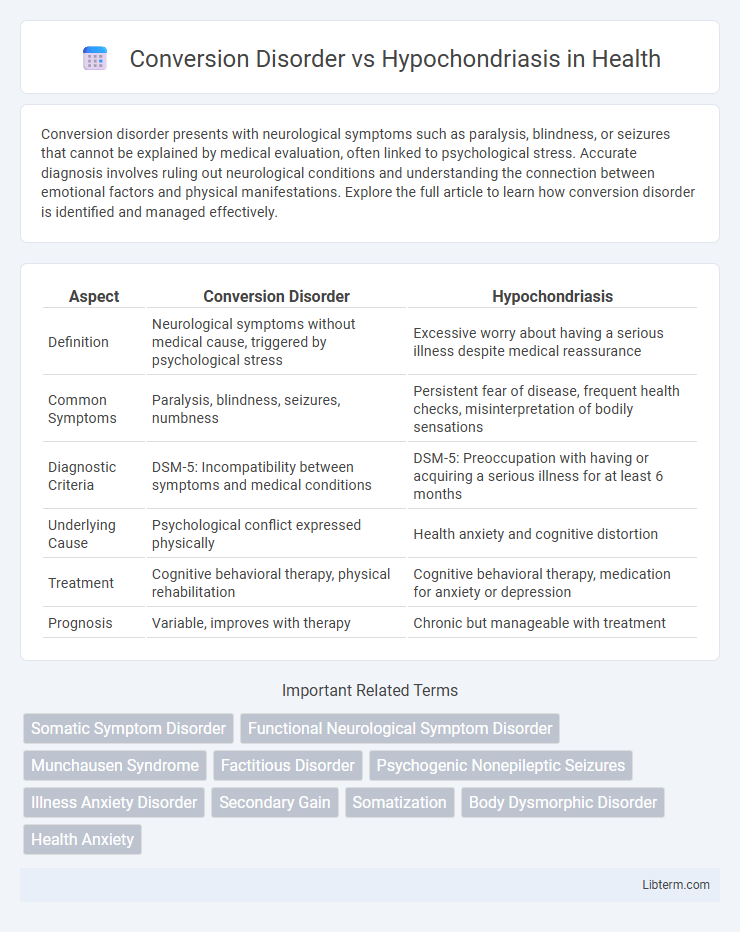Conversion disorder presents with neurological symptoms such as paralysis, blindness, or seizures that cannot be explained by medical evaluation, often linked to psychological stress. Accurate diagnosis involves ruling out neurological conditions and understanding the connection between emotional factors and physical manifestations. Explore the full article to learn how conversion disorder is identified and managed effectively.
Table of Comparison
| Aspect | Conversion Disorder | Hypochondriasis |
|---|---|---|
| Definition | Neurological symptoms without medical cause, triggered by psychological stress | Excessive worry about having a serious illness despite medical reassurance |
| Common Symptoms | Paralysis, blindness, seizures, numbness | Persistent fear of disease, frequent health checks, misinterpretation of bodily sensations |
| Diagnostic Criteria | DSM-5: Incompatibility between symptoms and medical conditions | DSM-5: Preoccupation with having or acquiring a serious illness for at least 6 months |
| Underlying Cause | Psychological conflict expressed physically | Health anxiety and cognitive distortion |
| Treatment | Cognitive behavioral therapy, physical rehabilitation | Cognitive behavioral therapy, medication for anxiety or depression |
| Prognosis | Variable, improves with therapy | Chronic but manageable with treatment |
Understanding Conversion Disorder: An Overview
Conversion disorder, also known as functional neurological symptom disorder, manifests as neurological symptoms such as paralysis, blindness, or seizures without a medical cause, often linked to psychological stress. Unlike hypochondriasis, where individuals obsessively worry about having a serious illness despite medical reassurance, conversion disorder symptoms are involuntary and not consciously produced. Understanding conversion disorder involves recognizing the complex interplay between the mind and body, highlighting the need for a comprehensive biopsychosocial approach in diagnosis and treatment.
Defining Hypochondriasis: Key Features
Hypochondriasis, also known as health anxiety or illness anxiety disorder, is characterized by excessive worry about having a serious medical condition despite medical evaluations showing no significant illness. Key features include persistent preoccupation with bodily symptoms, misinterpretation of normal sensations as signs of severe disease, and high levels of anxiety related to health. Unlike Conversion Disorder, which involves neurological symptoms without a medical cause, Hypochondriasis centers on chronic fear of illness and health-related distress.
Core Differences Between Conversion Disorder and Hypochondriasis
Conversion Disorder involves neurological symptoms such as paralysis or blindness without a medical cause, reflecting an unconscious psychological conflict, whereas Hypochondriasis is characterized by excessive preoccupation with having a serious illness despite medical reassurance. Conversion Disorder presents with genuine neurological impairments, while Hypochondriasis centers on persistent health anxiety and misinterpretation of normal bodily sensations. The core difference lies in symptom manifestation--functional neurological symptoms in Conversion Disorder versus health-related anxiety in Hypochondriasis.
Common Symptoms and How They Manifest
Conversion Disorder and Hypochondriasis share common symptoms such as unexplained physical complaints, including pain, numbness, or weakness. In Conversion Disorder, symptoms manifest as neurological deficits like paralysis or blindness without a medical cause, often triggered by psychological stress. Hypochondriasis involves persistent preoccupation with having a serious illness, where physical symptoms are misinterpreted or exaggerated despite medical reassurance.
Underlying Psychological Factors
Conversion Disorder involves unconscious psychological conflict manifesting as neurological symptoms such as paralysis or seizures, often linked to trauma or severe stress. Hypochondriasis, or illness anxiety disorder, is characterized by persistent preoccupation with having a serious illness despite medical reassurance, driven by health-related anxiety and cognitive distortions. Both conditions highlight the critical role of underlying psychological factors, including anxiety, stress, and maladaptive coping mechanisms, affecting somatic symptom expression.
Diagnostic Criteria: DSM-5 Insights
Conversion Disorder is characterized by neurological symptoms such as paralysis, blindness, or seizures that cannot be explained by medical evaluation, with diagnosis relying on criteria outlined in DSM-5 including the presence of one or more symptoms affecting voluntary motor or sensory function and clinical findings demonstrating incompatibility between symptom and recognized neurological conditions. Hypochondriasis, classified under Somatic Symptom and Related Disorders as Illness Anxiety Disorder in DSM-5, involves excessive worry about having or acquiring a serious illness despite medical reassurance and minimal or no somatic symptoms, emphasizing persistent health anxiety and maladaptive health-related behaviors. The key DSM-5 distinction lies in Conversion Disorder's focus on neurological symptom presentation without medical explanation versus Hypochondriasis' predominant preoccupation with illness fears and health anxiety.
Approaches to Treatment and Management
Conversion Disorder treatment prioritizes cognitive-behavioral therapy (CBT) and physical rehabilitation to address neurological symptoms without a medical cause, while hypochondriasis management involves psychotherapy, particularly CBT, to reduce health anxiety and excessive health-related behaviors. Pharmacotherapy, such as selective serotonin reuptake inhibitors (SSRIs), may be effective in both conditions to alleviate associated depression or anxiety. Multidisciplinary care including mental health professionals, neurologists, and primary care providers enhances treatment outcomes and patient quality of life.
Impact on Quality of Life and Daily Functioning
Conversion disorder often leads to significant impairment in motor or sensory function, severely restricting daily activities and reducing overall quality of life due to unexplained neurological symptoms. Hypochondriasis primarily causes chronic anxiety about health, resulting in frequent medical consultations and persistent worry, which disrupts social interactions and work performance. Both disorders necessitate targeted psychological intervention to improve coping strategies and restore functional abilities.
Myths and Misconceptions Debunked
Conversion disorder is often misunderstood as deliberately faking symptoms, but it is a genuine neurological condition where psychological stress manifests as physical symptoms without a medical cause. Hypochondriasis, now termed illness anxiety disorder, is commonly mistaken for simple worry or attention-seeking, yet it involves persistent, excessive fear of having serious illness despite medical reassurance. Both conditions require empathetic, evidence-based approaches, as myths about malingering or excessive dramatization undermine proper diagnosis and treatment.
When to Seek Professional Help
Seek professional help for Conversion Disorder when experiencing sudden neurological symptoms like paralysis, seizures, or numbness without a medical cause, as early diagnosis can prevent complications. For Hypochondriasis, consult a healthcare provider if persistent anxiety about having serious illnesses affects daily functioning despite negative medical tests. Timely intervention by a mental health specialist is crucial in both cases to manage symptoms and improve quality of life.
Conversion Disorder Infographic

 libterm.com
libterm.com